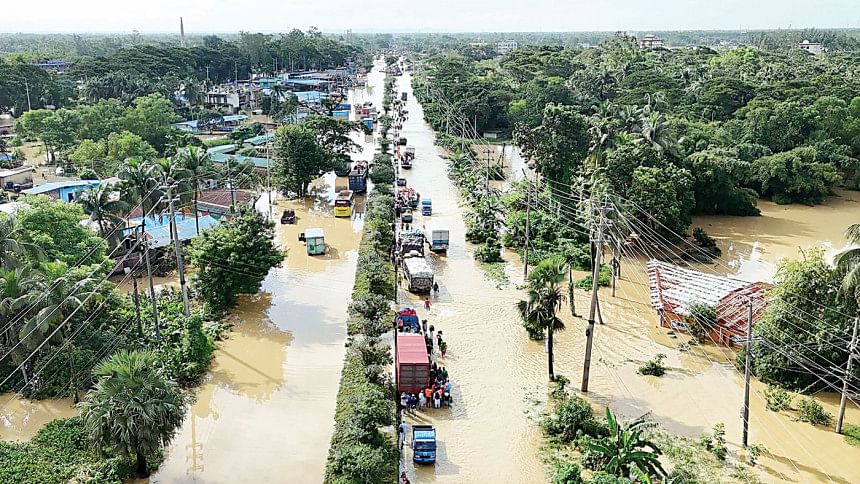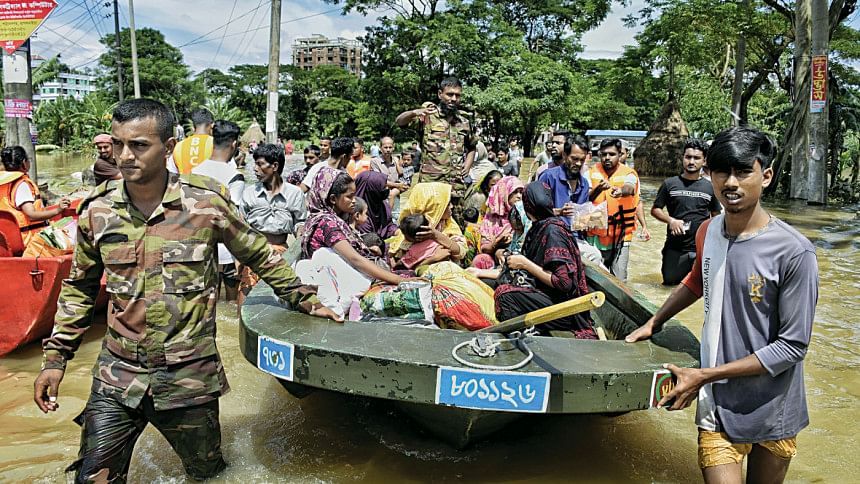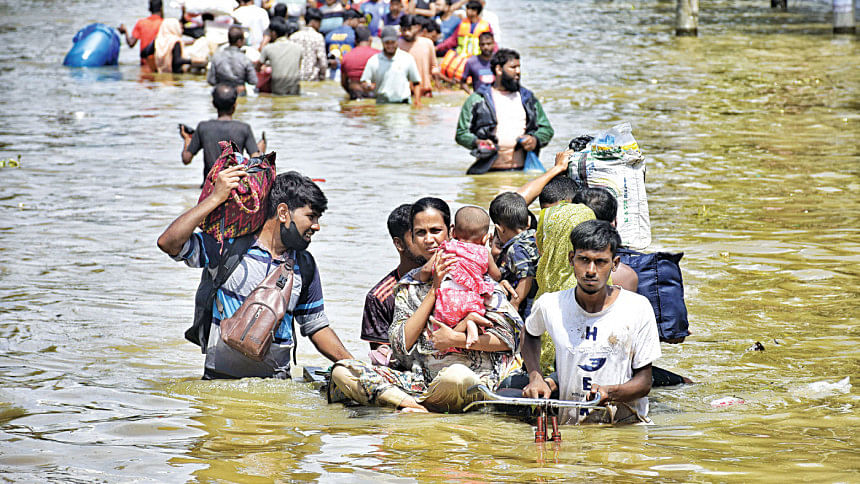Millions cut off without food, power
Millions of people were still left without electricity and any means of communication, and relief materials had not reached many remote areas where families were stranded in flooded villages for days.
Even the shelters opened by the government in the affected districts have become overcrowded yesterday, locals said.
The situation was particularly dire in Feni, Noakhali and Cumilla where relief materials had not reached many remote areas.
Five upazilas of Feni still remained inaccessible by road yesterday even as the waters were receding.
Family members could not reach each other over the phone as almost every cell phone tower in the district was offline.
Locals said there were severe crises of drinking water and food in many areas of the district.

“Our house was submerged. We only had time to go to the roof of a neighbour’s house. The water gushed in very fast. The walls of the corrugated iron sheet of our hut fell apart within a short time. Soon, the water was as high as the tin roof of our house,” said 45-year-old Aleya Begum, a resident of Khopal area of Chhagalnaiya upazila.
She, her 70-year-old mother-in-law Saleha Begum, and six others of the area had spent three days on the roof of their neighbour’s one-storey building.
Saleha said, “I have never fought such a battle with water. I thought I was dying. We cannot contact anyone. My husband and sons had not returned home. We survived only on some dry food and little drinking water.”
Officials said three people drowned in the flood-affected districts yesterday, taking the toll from the floods to 18.
“We only had time to go to the roof of a neighbour’s house. The water gushed in very fast. The walls of the corrugated iron sheet of our hut fell apart within a short time. Soon, the water was as high as the tin roof of our house.”
According to a statement from the chief adviser’s office, almost 9.8 lakh people were marooned in 11 districts. They were in desperate need of drinking water, oral saline, and food.
About 50.94 lakh people in 77 upazilas of 12 districts have been affected by the floods so far.
Over 3 lakh people took shelter at the 3,513 shelters opened by the government.

As the downpour stopped, the situation improved in Cumilla, Noakhali, Brahmanbaria, Laxmipur, Sylhet, Moulvibazar, Habiganj, Khagrachhari, Rangamati, Chattogram, and Cox’s Bazar, said the Flood Forecasting and Warning Centre.
However, more areas were flooded in Senbagh upazila of Noakhali yesterday and there was a severe crisis of drinking water and food in eight upazilas.
Sobhan Miah, a 68-year-old farmer in Char Elahi village of Companiganj, said he had not drank safe water in a week.
“The water is receding, but there is still two foot deep water in my house. There is no rice and the stove is submerged. We are starving,” he said, requesting a correspondent of this newspaper to send some relief materials.
Many residents of the area could not go to a shelter because they did not have boats.
Muhammad Yusuf, his 58-year-old neighbour, said, “There are no means to go anywhere. We are forced to sit on the cot the whole time.”
The water levels of the Khowai dropped below the danger level in Habiganj town, the Manu in Kulaura, the Gumti in Debidwar, and the Halda in Fatikchhari.
Several rivers were still flowing above the danger mark in Cumilla, Sylhet, and Moulvibazar.
Officials said another bout of downpour is not likely in affected districts and the upstream regions of India today and the situation would improve in Feni, Cumilla, and Chattogram.
Meanwhile, Chief Adviser Prof Muhammad Yunus yesterday urged the government agencies, NGOs, student organisers, volunteers and expatriates to work in a coordinated manner to help the people in distress.
He made the call at a meeting with 44 NGOs at the state guest house Jamuna, said his Press Secretary Shafiqul Alam.
After the meeting, BRAC Executive Director Asif Saleh said he told the chief adviser that post-flood management should be done through coordinated efforts, zone-wise activities, and relief collection as per demand.
Representative of an NGO told Prof Yunus that Tk 1,000 crore may be needed for the post-flood management.
Officials in Chattogram said 2.7 lakh people were stranded in the district.
The authorities were scheduled to release water from the Kaptai dam in Rangamati today. Officials said it would have no effect on the floods.
LondonGBDESK//



Comments are closed.